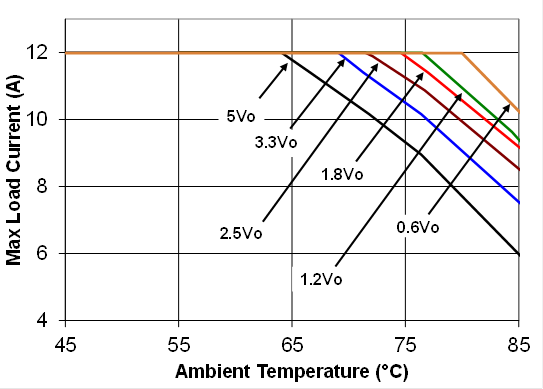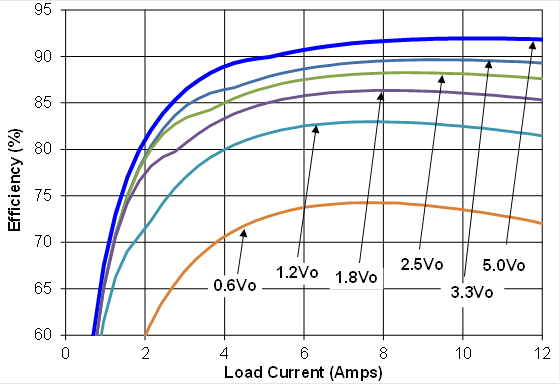Historically, designers searching for low-profile, completely digital point-of-load (PoL) power supplies only found compromises. The device they found might be digital, but too large or too tall; or it might have a limited input/output range and insufficient output current at real application temperatures and conditions. Or it could have been thermally challenged, or it required an independent external voltage, meaning extra devices, extra costs, and various and sundry difficulties in design and manufacturing.
Breakthroughs in thermal encapsulation technologies, packaging innovations, and, of course, digital capabilities have enabled dc/dc power solutions with little compromise. Some modules can achieve 40% greater power density over comparable previous-generation devices, 95% efficiency, a wide operating range (3 to 14.5 VIN with 4.5 to 5.5 VOUT ) and real power throughput of 12 A in less space than any other full range module with a 20.32 x 11.43 x 3-mm footprint. By coupling these achievements with manufacturing innovations that allow deployment anywhere on circuit boards – top or bottom sides and even on mezzanine daughtercards – designers now don’t have to settle for less.
Keeping its cool
Although several advancements were needed to make these all-in-one power modules possible, one of the most critical was a new generation of encapsulation technology. Encapsulation is usually considered a thermal management technology and this new generation of modules certainly excels at diffusing heat uniformly across the device, but just as important are some of the other effects that these new encapsulation techniques have enabled.
Innovations in materials science have played a huge role in improving encapsulation technology, but other factors, such as how the material is applied, the design of the power module itself and the precision of the module’s fabrication environment are just as critical to more effective thermal performance.
One of several beneficial effects of better heat dissipation from innovative encapsulation technology has been unmatched power density without sacrificing features. Because these modules can move heat away from hot spots and shift it to other areas, the device is able to output more current than similarly sized modules. In fact, based on real-world performance benchmarks, one example of such a device, the SlimLynx module, has shown that it can output up to 12 A with 12 VIN and 1.2 VOUT at 75°C (see Figs. 1 and 2 ) with no additional airflow. Even at the rated full output power of 66 W with 12 VIN , 12 A, and 5.5 VOUT , such devices can operate without derating at over 60°C without any airflow. This represents 95 W/cm3 without air cooling. This outstanding performance can even be achieved in a closed box. High-quality encapsulation technology such as this can accelerate a new product’s time to market because design and manufacturing processes are simplified.

Fig. 1: Thermal derating of the SlimLynx module at 12-VIN for various output voltage set points.

Fig. 2: Plot of the efficiency of the SlimLynx module at 12 VIN and 25°C for various output voltage set points.
In manufacturing, for example, some low-profile digital PoL power modules cannot survive the higher reflow solder temperatures required by certain lead-free RoHS-compliant processes. This significantly reduces the markets that the end product can address, which limits its value. When the encapsulation technology of a PoL module can withstand the higher reflow solder temperatures, it can be deployed globally without sacrificing power performance.
Gateway to digital innovation
Besides advanced encapsulation, a few of the 3-mm-high full-range PoL modules are digital, which means the device can act as a gateway or portal into the world of digital innovation. In addition to saving room on a board design for greater functionality by integrating the many associated resistors, capacitors and other types of devices that usually accompany analog solutions, these digital dc/dc supplies also include digital communications capabilities. Some even conform to the Distributed Power Open Standards Alliance (DOSA) specification, and support inter-integrated-circuit (I2 C) connectivity with Power Management Bus (PMbus) protocol functionality.
Through this digital portal, these modules give designers, users, and even the system’s operating firmware the kind of visibility that had previously been impossible. Designers might use this access to monitor the ongoing power conditions of the system so the power set points may be altered dynamically. This insight can be a powerful debugging tool during development and a useful access method for controlling the power parameters of a system remotely.
For example, during the development of a high-speed, high-throughput communications board for wireless base stations the designer could monitor the power consumption of a critical field-programmable gate array (FPGA) and discover that the device is consuming far more power than expected. A further analysis of how the firmware is being processed by the FPGA could lead to code revisions that yield more effective code execution and reduced power consumption. Of course, this is just the tip of the iceberg when it comes to what can be accomplished through the digital capabilities of this new breed of digital POL modules. The only real limitations on such devices are the ingenuity and creativity of designers.
Ease of use
Other innovations in packaging technologies also make these devices easy to be designed into new product designs and to be assembled onto high-quality circuit boards. For instance, some feature innovative solder grid array packaging that can simplify design, improve manufacturing yields, and increase reliability in the field.
This type of ball-grid-array packaging technology incorporates additional controlled solder bumps on the underside of a surface-mount (SMT) power module. This reinforces the solder joint reliability of an assembly by providing additional points where the module attaches to the underlying circuit board. These extra solder bumps ensure that each pad mates with the main board’s solder paste during manufacturing. Moreover, the extra solder bumps function in concert with the module’s encapsulation technology to increase the thermal efficiency of the device and the system. The interconnect resulting from power grid array packaging can improve heat transfer from hot spots on the module, resulting in a more uniform temperature distribution between the main circuit board and the power module. Encapsulation, advanced packaging, and other features make it possible for a few of these new modules, such as the SlimLynx, to drive the full load rating of 12 A at 75°C with no airflow at all.
Of course, today’s densely populated circuit boards often challenge designers to find any real estate on a design for PoL power modules. Because of the low profile and slim dimensions (20.32 x 11.43 x 3 mm) as well as the rectangular shape of some all-in-one PoL devices, designers can fit the module where one could not have been placed previously. In fact, the relatively narrow rectangular shape requires less board space than a square configuration and lets designers place the device on narrow “runway” areas of the board that are not well suited to the typical square device. Additionally, unlike some older modules, certain devices in this new generation of dc/dc supplies have advanced mechanical construction that makes them compatible with reverse solder reflow. As a result, they can be placed on the back side of a board even though this would require a second pass through reflow. Alternatively, the module could be designed into a mezzanine daughtercard assembly, saving motherboard real estate that the designer could devote to other resources or capabilities.The continuous, clean, and flat surfaces of some of these modules also make them compatible with high-speed pick-and-place assembly machines, accelerating the manufacturing process further.
Advertisement
Learn more about GE Energy





